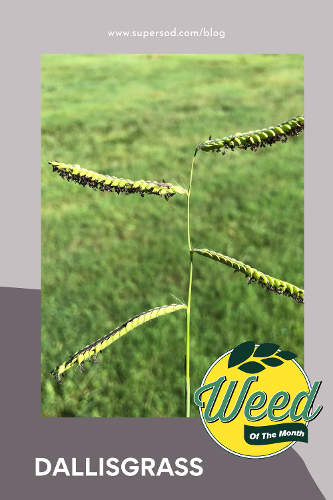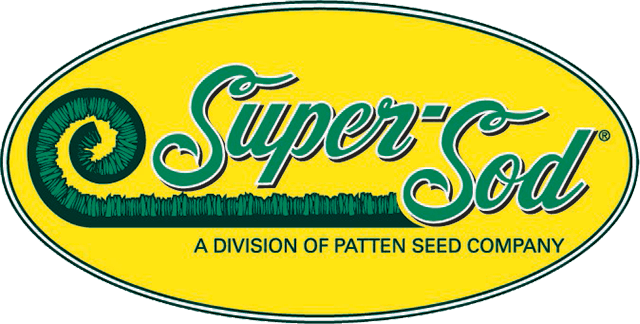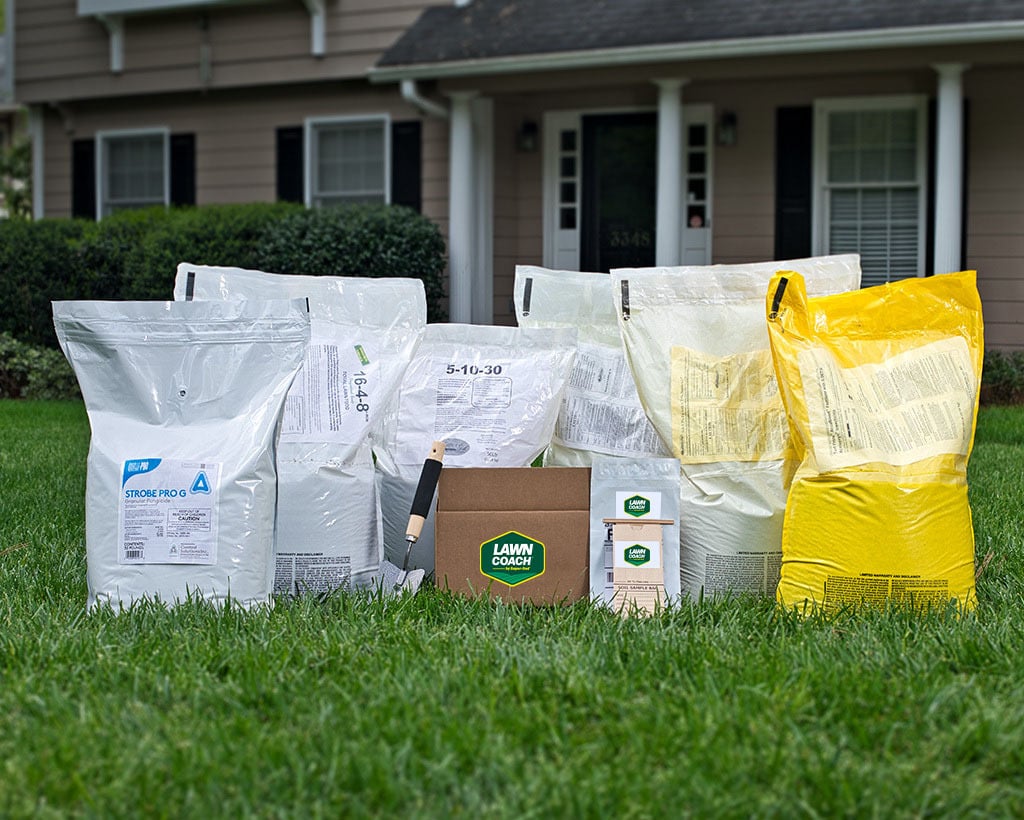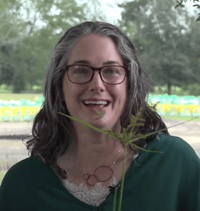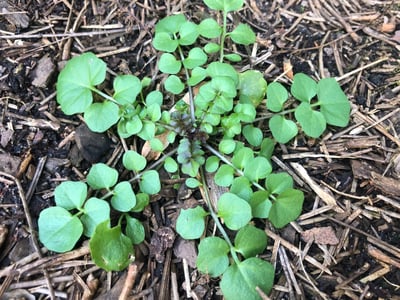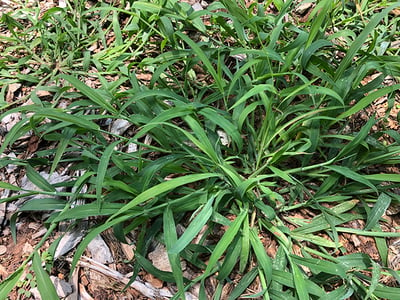
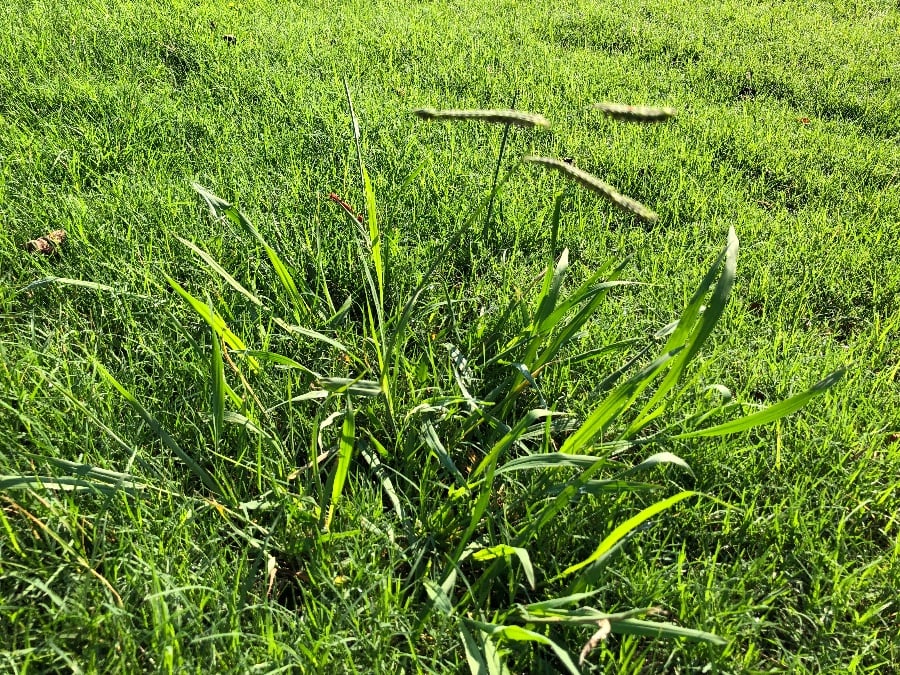
This month's featured weed is Paspalum dilatatum aka dallisgrass. We'll cover how to identify and control it.
With this dallisgrass profile, we conclude a series on three common, coarse-textured grassy weeds in the Southeast that people are trying to identify in their lawns. Don't get me wrong, there are other grassy weeds, but crabgrass, goosegrass, and dallisgrass are the three lookalikes we get asked about the most. Now, on to learning about dallisgrass!
Viewing Tip:Increase the volume and the playback speed according to your preferences. Volume control is the speaker icon on the lower left; playback speed is the gear button on the lower right.
Dallisgrass ID Features:
To control dallisgrass, we first need to learn how to identify it.
- Family: Dallisgrass is in the Poaceae family, commonly called the grass family.
- Habit: This grass mostly grows in clumps. While it does sometimes produce spreading rhizomes, those rhizomes are so short that the whole plant basically looks like a clump; often the short rhizomes for a clump with an empty center that gets recolonized by the Bermudagrass lawn it has infested. It's a unique look.
- Flowers: Flower stalks on dallisgrass can shoot up faster than you can get back out to mow. They seem to outpace the lawn by 2-3 feet with flowers that rapidly go to seed. This is one reason why consistent mowing is so important.
- Racemes: Dallisgrass racemes alternate back and forth along the stem in groups of 2 to 10 slightly nodding "fingers." I most often see 2 to 5 with a single terminal raceme.
- Seeds: The big black seeds are conspicuous and a key identification tip. Bahia grass has similar seeds and racemes, but bahia's racemes form a terminal V that will help you easily separate the two grasses.
- Leaves: Coarse-textured thus looking a lot like crabgrass and goosegrass. This is what gets people confused. Once you study the three and memorize their unique ID features, you'll be able to separate them at a glance.
- Stems: There are no stolons and the above-ground leafy stems don't root at the nodes, so in this instance you're safe. We already discussed how there are sometimes short, slow, spreading rhizomes. (Rhizomes and stolons are specialized types of stems, so maybe I should have covered that here, but it came up in conversation in the "habit" section.)
A clump of dallisgrass with short rhizomes that formed an open center. The surrounding Bermudagrass lawn is filling in the center. This happens a lot and is a good ID feature.
Here's a clump of dallisgrass throwing long flowering stalks. Long stalks often flop over like this.
Dallisgrass flowers going to seed. Note the slightly nodding racemes. When you see these black "poppy seeds," there will soon be more dallisgrass to contend with.
This perennial grass loves full sun and wet or moist soils. The picture below shows it in a ditch with flowering stems outpacing the Bermuda (that by the looks of it should have been mowed 4 days ago).
Learn more about dallisgrass from these websites:
- NC State Extension features dallisgrass
- UGA has dallisgrass listed in its database
- Excellent in-depth info from Texas A&M AgriLife Extension: Dallisgrass in Turfgrass
Dallisgrass loves a good ditch. It thrives in the extra water that pools in low lying areas.
Eat it or Treat it - How to Control Dallisgrass
Dallisgrass is in the Poaceae family. Many Poaceae family members are edible, but I'm unable to find mention of people eating this weed.
This grassy weed has naturalized in the Southeast from its original home in South America. It was introduced to the US as a forage grass and is sometimes still used as such, but not by anybody we know - everyone we know wants to get rid of it!
Because dallisgrass is one of the hardest weeds to get rid of once it's growing in your lawn, prevention is the best form of control.
Dallisgrass Prevention:
- #1 Best tip for Dallisgrass Control: In February spread pre-emergent herbicide to prevent germination of summer weeds, such as dallisgrass. Dallisgrass germinates in winter so if you have a dallisgrass infestation, we recommend you don't miss applying pre-emergent in early February. If you subscribe to our email we'll send you an email reminder or sign up for Lawn Coach and we'll send the pre-emergent to you at the right time.
Note: Because Dallisgrass is a perennial, pre-emergents won't remove existing plants, but they are effective in preventing new plants from growing. - Prevent dallisgrass in beds with thick layers of mulch and by cultivating a thick, healthy lawn.
- Since dallisgrass prefers low-lying and periodically wet areas, those areas may be where you have the worst infestations. Try correcting any problems with standing water by diversion or adding topsoil.
Manual Removal of Dallisgrass:
- Dig it up: Hand pulling is a satisfying option for many of the weeds we discuss in this series, but not so with dallisgrass. This simply is not an option. Dallisgrass is shovel work.
- Mow to keep plants from going to seed. I have read a report that if you've planted dallisgrass as a forage crop, then be sure to mow above 3" because it doesn't like it any lower. That's a pretty good hint that if you're mowing your lawn weekly (or more often), then you shouldn't have a dallisgrass problem. The scientific term for mowing to stunt weeds is "depleting carbohydrate reserves through biomass reduction." It's a mouthful that works!
- Time/patience: Since dallisgrass is a perennial, you can't simply wait for hard frosts to kill it off. Your patience is going to be frazzled by this weed. It will take long-term persistence and patience to get rid of it using the tips herein.
Chemical Control of Dallisgrass:
- A non-selective herbicide can be sprayed to kill the clumps of dallisgrass, but it will also kill the surrounding lawn. You can put down a barrier (such as cardboard) to help protect your lawn when you spray out the dallisgrass. Sometimes the infestations are so thick that you'll spray out a significant area. In that case, you can wait for your warm season lawn to grow back in and fill in the bare spots or you can get individual rolls of sod and cover those bare spots before more weeds germinate there.
- Dallisgrass is often difficult to kill with the selective and non-selective (glyphosate) post-emergent herbicides available to those without a professional license. Generally speaking, with "over the counter" post-emergent herbicides, dallisgrass turns yellow, but persists and regrows. Most homeowners have to either hire a pro or dig it out.
- A tip from the Texas A&M Extension article linked above is to apply a non-selective herbicide twice in the autumn and one more time in the spring to eradicate it. For more info about this, watch our video posted at the beginning.
Questions? Leave a comment below.
If you're a weed aficionado like me, check back here for future Weeds of the Month. Until then, happy weeding!
Special thanks to Greg Nichols, Michael Noctor, and Brandon Eubanks for contributing dallisgrass ID and treatment tips. All pictures by Hillary Thompson.
